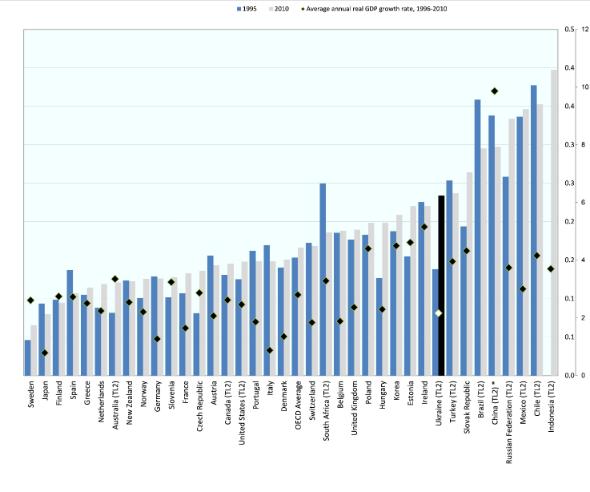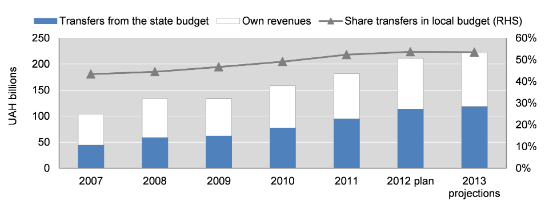Regional development
OECD Territorial Reviews: Ukraine
Key facts and policy issues | Table of contents | Recommendations
Key facts and policy issues
Key facts
- Ukraine’s regions continue to struggle economically, having failed to regain the growth momentum they enjoyed in the years before the crisis hit in 2008-09. Export demand remains muted, and domestic demand growth is constrained by slow credit growth, lack of fiscal space and an institutional environment that is not conducive to investment.
- Inter-regional disparities are large by OECD standards and they continue to increase. However, they are not out of line with those of Ukraine’s peers. The increase in disparities has been driven almost entirely by the city of Kyiv, with most other regions’ contributions to growth being roughly in line with their size.
Gini coefficient for average per capita GDP by region

Note: Ratio between the largest and smallest TL2 regional values.
Source: OECD.Stat and State Service of Statistics of Ukraine.
- There is evidence of significant disparities in access to basic services, especially education. Moreover, the human development index deteriorated in most Ukrainian regions during 2000-10, and only 12% of the population lived in regions where it improved.
- Productivity performance in much of Ukraine has been relatively poor. The industrial capital stock is limited and deteriorating. The large informal labour market makes it difficult to assess labour-market trends with precision but the link between education and productivity appears to be weak.
Key policy issues
- Ukraine is a highly centralised polity. There is wide agreement on the need for greater decentralisation, but sub-national governments often face capacity challenges and they are extremely fragmented at lower levels, making it impossible to realise economies of scale or even to perform some basic service-provision functions effectively.
- Sub-national governments tend to depend heavily on central transfers, the allocation of which they find at times to be both unpredictable and less than transparent. Reforms to sub-national public finances have been in preparation for some time and need to be taken forward. Lack of resources combined with weak arrangements for the assessment of service quality mean that access to good-quality public services remains a challenge for many.
Dependence on central government transfers (values in UAH billions)

Source: Ministry of Finance.
- Regional development policy is undergoing a major legislative and institutional overhaul, after a decade of incomplete reforms. This presents both a challenge and an opportunity: the governance of regional development policy needs to be strengthened, the range of instruments used needs to be broadened and clarified, and the mechanisms for performance monitoring and evaluation need to be enhanced.
Ukraine has taken a number of steps to bring its regional policy framework into line, focusing on investment, competitiveness and a multi-sector horizontal approach, as opposed to using subsidies and transfers to pursue compensatory objectives via a top-down sectoral policy. However, the current regional policy framework still lays great stress on traditional compensatory measures, and the degree to which the shift towards the new paradigm is reflected in day-to-day practice will depend on how the authorities tackle the implementation challenges associated with recent and currently pending reforms, as well as their success addressing the governance and policy gaps described above. The current tight fiscal environment will make it even harder to meet these challenges but it also makes implementation success more important than ever.
Key recommendations
- Revise the formulae for the allocation of transfers to sub-national tiers of government in order to make it simpler and less discretionary, by reducing the number of indicators used in the formula. Resources allocated for the provision of local public services should be based on the needs of the population in each area, not input indicators.
- A territorial reform should be implemented prior to any decentralisation of functions to lower levels of government; such a reform should facilitate municipal mergers and the further development of new forms of inter-municipal co-operation; simplify the legal procedures involved in transferring competences to joint bodies or companies; and provide additional incentives to jurisdictions that implement new types of co-operative relationships.
- Revise the revenue structure of the oblasts, Crimea and the cities of Kyiv and Sevastopol to allow them to retain any extra revenue generated at the oblast or local level.
- Introduce a property tax to enhance municipal financial capacity; its introduction should be preceded by the creation of a reliable cadastre.
- Create a monitoring system for the effectiveness of the policies implemented, with special reference to local public goods and services.
- Revise the allocation rules for the State Fund for Regional Development (SFRD) so as to avoid sharp differences in the treatment of similar places. This should be accompanied by steps to enhance the transparency of allocation of other central transfers to sub-national governments.
- Use the SFRD as an instrument to foster inter-regional co-operation; link such efforts to broader national projects and priorities.
- Make greater use of SFRD allocations to promote experimentation with “softer”, more flexible instruments for regional development. Issues related to disparities in the provision of basic services should be addressed via equalisation transfers and/or safety nets.
- Make a rigorous cost-benefit analysis of any special zones or industrial parks, designing them with reference to international best practice, particularly by working to:
- minimise spatial distortions and maximise the zone’s integration with the wider economy;
- focus on “non-addictive” forms of support that will foster new, self-sustaining activities rather than on-going dependence;
- use special zones to pilot reforms that could then be scaled up, possibly including the piloting of decentralisation reforms that could empower regions and cities.
- Better focus the support to entrepreneurship on underused labour in different regions (e.g. women) and further promote social entrepreneurship through partnerships with local and regional authorities.
- Strengthen the co-ordinating and strategic role of central co-ordinating bodies (like the inter-departmental commission) that deal with regional development policy, vis-à-vis both other ministries and with lower levels of government.
- Implement stronger contractual arrangements to support Regional Development Programmes, with an obligatory status and integration into national and sub-national budgets. Use the contracts as an instrument for agreeing on medium-term SRDF priorities.
Table of contents
Acronyms and abbreviations
Executive summary
Assessment and recommendations
Chapter 1: Regional trends and Ukraine's productivity challenge
Introduction
The macroeconomic context
Sub-national trends
Behind the trends: Inputs to growth and productivity
Chapter 2: Improving Ukraine's sub-national level governance and service provision
Introduction
The current system of territorial governance in Ukraine
Decentralisation reforms in Ukraine
Provision of local public goods
Conclusion
Chapter 3: Strengthening regional development policy in Ukraine
Introduction
Putting regional development policy in context
The evolution of regional policy in Ukraine
Building a more effective regional development policy
Improving regional development policy institutions
Strengthening regional development policy instruments
Related Documents
